WDFW Approves razor clam tides: May 10th- May 15thTides Last tides of the season. Halibut Season Starts May 1st Bottom Fishing opens March 8th
Oyster Facts
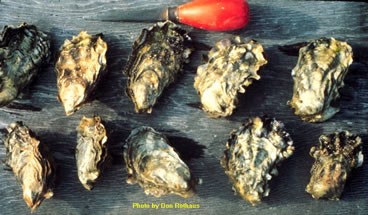 Pacific Oyster
Pacific OysterBiology
Oyster facts of the Pacific Oyster. When condition are right the female Pacific oyster may spawn up to 200 million eggs in a season, expelling them into the water where they are fertilized by sperm from the male.
Only a very few of these eggs, of course, develop to mature larvae; and still fewer are able to find suitable hard, clean surfaces to set. Thus, the large spawning represents nature's provision against the enormous number of casualties which may be expected.
The fertilized eggs develop into shelled larvae and spend 3-4 weeks swimming or drifting freely with the tide before instinctively seeking some clean, solid surface on which to attach themselves.
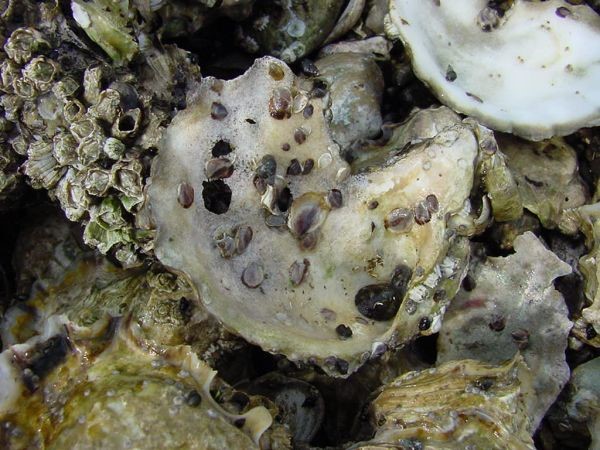
The spat, as the minute oysters are then called, are pin point size but by the advent of winter become more easily visible.
The Pacifics may reach four-inches in shell size by the age of two years, whereas the slower growing Olympia is only 11/2 inches long when it reaches maturity at four years.
Pacific oysters exhibit the unusual phenomenon of sex reversal. On a yearly basis it may alter sex between male and female thus living -in the words of the late Professor Trevor Kincaid -"the life of a sort of Dr. Jekyll and Mrs. Hyde".
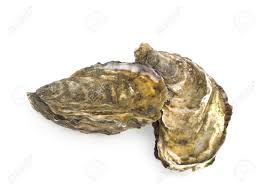 Pacific Oyster
Pacific OysterDuring warmer summers, natural spawning from Pacific oysters may account for as much as two-thirds of the needed supply of seed. Best spawning conditions for the Pacifics occur at water temperatures above 65 degrees and failure of the sea water to attain that warmth has a direct effect on the success of the season's spawning.
The major source of oyster seed is currently Northern Hood Canal with some seed produced in Willapa Bay and Pendrell Sound (Canada). However, since most growing areas do not become warm enough for setting, individual growers must procure seed from one of the above sources.
Food
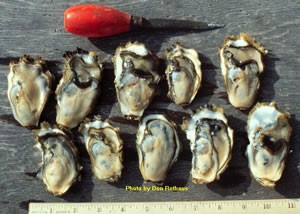
Oysters are famous for their nutritional qualities: they are rich in
- proteins,
- vitamins and
- trace elements as iron, iodine, copper, phosphorous, cobalt, and manganese,
which individually or in combination are essential contributors to a healthy body.
In feeding, oysters pump sea water through the body cavity and ingest virtually all of the microscopic animals, bacteria, and tiny plants that pass by them daily with the tide. The process consists of the food being extracted from the water through sieve-like gills covered with small cilia, or hairs, whose rhythmic waving causes a current of water to pass through the oyster. As the water is pumped over the gills, the food organisms are captured in strings of mucus, then carried along the gill edges toward the mouth for ingestion.
Oysters can be said to "graze" upon the meadows of the sea, and convert to human benefit the abundance of tiny floating plants forming these "meadows." They are able to utilize organisms less than 1/50th of a millimeter in size. (Many of these organisms are known as flagellates). However, even within this group of minute organisms there are some which provide nutrition for the oyster and some which probably do not. It is still unknown exactly which of the organisms are principally digested and utilized as food by the oysters.
The R Month Fallacy Oyster Facts
It is thought by some that oysters are poisonous during the summer months (the months without R). This notion is entirely erroneous. Oysters are usually not marketed during the summer because this is the reproductive season of the bivalve and so much of its substance is expended in producing eggs and sperm that the meats are often too thin and watery for marketing.
Problems and Solutions
There are several types of common pests and predators that can damage oysters or the ground on which they are grown.
- Oyster drills,
- crabs, and
- starfish
are the most serious predators that attack oysters directly.
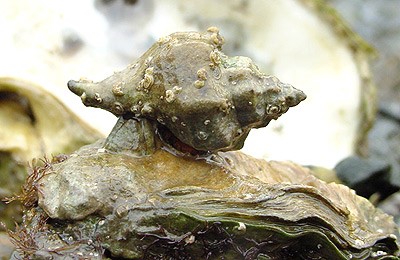 Oyster drill Ceratostoma inornatum) on top of oyster
Oyster drill Ceratostoma inornatum) on top of oysterThe Japanese oyster drill (Ceratostoma inornatum) was imported from Japan with the first planting of Japanese oyster seed in Samish Bay, Washington. It is a marine snail which drills a small hole through the shell of the young oyster and eats the meat.
This drill has been spread by the transplanting of oysters and has become established in many areas of the state.
These drills do not migrate by themselves, and it is, therefore, possible to control their spread by a quarantine system designed to prevent them from being taken accidentally or purposely onto drill-free tidelands.
Control of drills on an oyster bed is both difficult and costly, and for this reason it is vitally important for each oyster grower to make every effort to avoid introducing drills to his ground by careless transplanting practices. The damage drills cause varies from minor, in some oystering areas, to total kill of seed plantings in other areas.
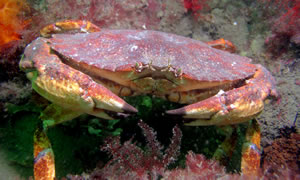
Crabs may cause damage to oyster plantings by breaking open and eating seed oysters and young growing oysters and, occasionally, oysters up to adult size.
The principal predatory crab is the red rock crab (Cancer productus) which is recognized by its heavy black-tipped claws and red shell.
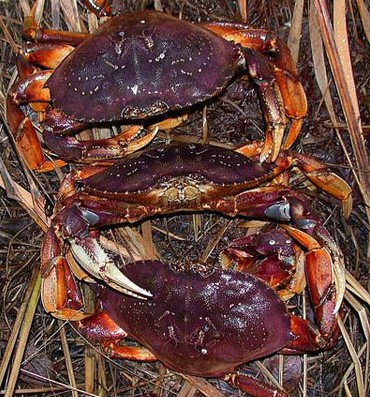
Occasionally, Dungeness crabs may attack oysters, but it has been determined that they will not attack unless extremely hungry.

Much otherwise desirable oyster ground may have dense populations of ghost shrimp which both soften the ground and cause burying of oysters.
These crayfish-like animals live in the bottom and, through their digging and water pumping activities, honeycomb the bottom and constantly deposit subsurface material on the surface which will bury and kill oysters put in the area.
If proven oyster ground becomes infested with ghost shrimp, many oyster growers make every effort to reclaim it by either controlling or destroying the shrimp with physical or chemical methods.
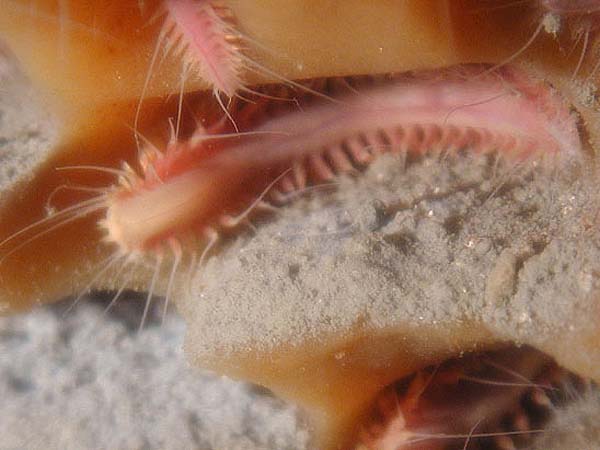
Occasionally, large burrowing worms will disturb the bottom and cause the small oysters to be buried and smothered in a manner similar to that caused by the ghost shrimp, However, it is fairly rare for worm abundance to be such that oyster grounds are made unusable. Starfish may become abundant on oyster beds in some areas and, if not quickly controlled, may cause severe loss to the adult oyster population.
Ice and excessive silt may also be problems for some oyster growth. Ice and mud are sometimes hard to deal with, particularly if they come in large quantities. (Ice is a problem when oysters freeze into a raft of ice and are floated away. Silt washed down from the mountains can bury and smother oysters.
 Webcam Westport, Washington
Webcam Westport, Washington